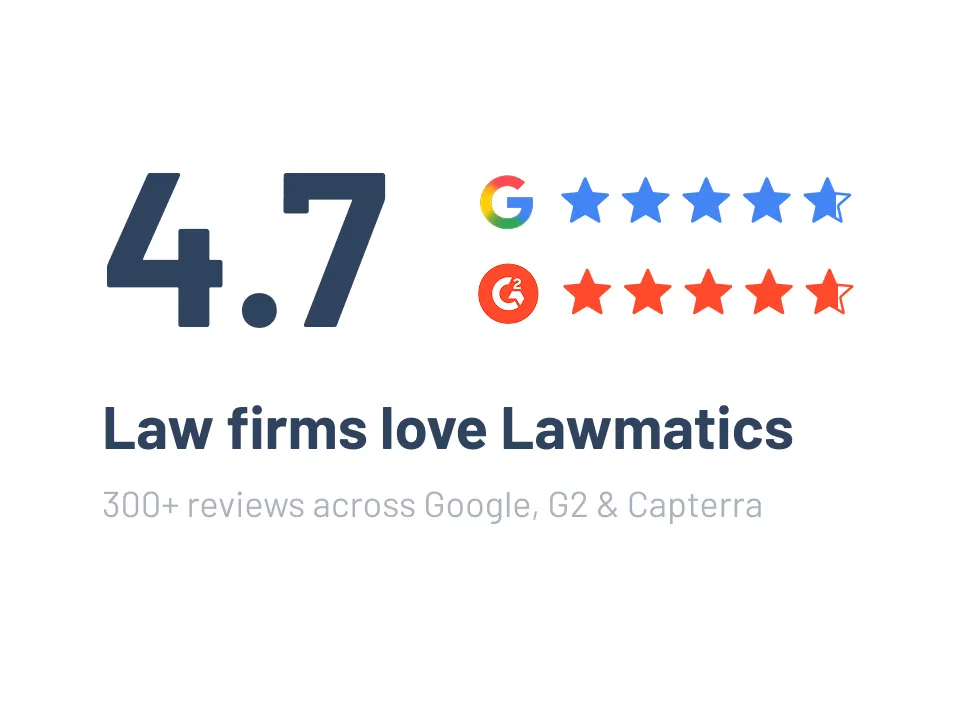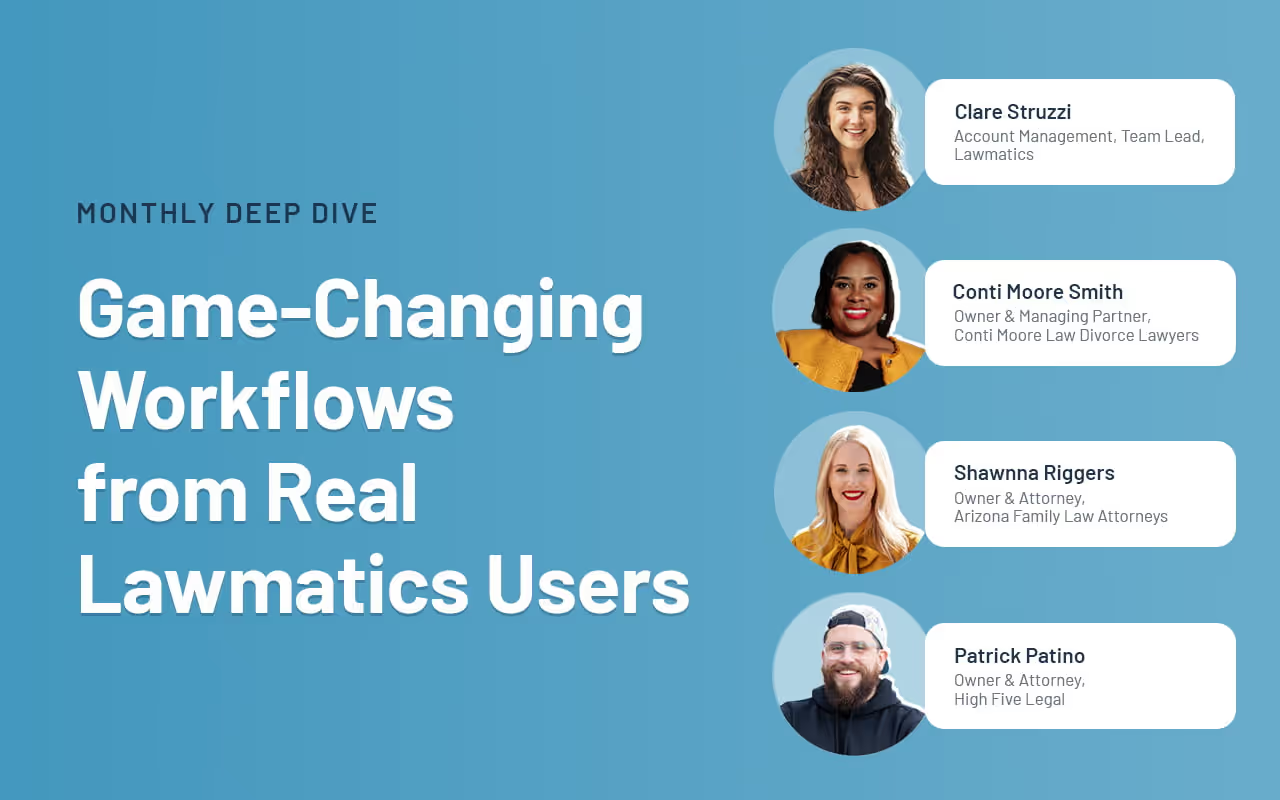The Lawmatics Blog
Insights on legal marketing, automating the law practice, and legal tech in general
As we head toward the end of the year, our team revisited the most meaningful product updates of 2025 and how they’re reshaping the way firms work. All year long, our product work has centered on the same core goal: removing the obstacles that slow firms down. That’s meant bringing key information to the surface when teams need it, cutting out friction in the client journey, and giving staff clearer ways to build and maintain their processes across the platform.
Time stamps of key takeaways
8:15 – New, intuitive navigation
Devon walks through the redesigned navigation, which brings the most-used areas — like Matters, Pipeline, Calendar, Tasks, and Automations — into a cleaner, left-hand layout for quicker access. Reminders, emails, and other tools that had previously been scattered across the app now live in central, easy-to-find locations. The goal is simple: fewer clicks, clearer groupings, and a workspace that reflects how firms actually move through intake.
26:20 – Get key info faster with MMS
The team shows how firms can now receive MMS messages directly into Lawmatics, allowing clients to text photos or documents straight into their matter. It’s especially useful for practices like personal injury, where images of an accident or ID documents are often needed quickly.
31:18 – Manage your emails in one place
Email tools have been fully centralized, replacing the old model where templates lived in different corners of the app. Everything — from document send templates to automation emails — can now be created, edited, and organized in one place. Folders help firms manage growing libraries of emails, and each template can be applied across multiple documents without duplicate versions.
36:55 – Build and maintain automations with less effort
Devon and Clare highlight the refreshed automation experience, which makes appointment-based and date-based workflows easier to find, build, and understand. Relative timing is now built directly into each automation, and shared entry rules help firms avoid recreating the same logic dozens of times. Automation builds can also now be grouped in folders, similar to how you organize your email library.
45:18 – Additional highlights
The session closes with a handful of smaller but long-requested additions, including improvements to round-robin scheduling, password-protected forms, Message Center filters, auto-pay for billing, and color-coded appointment types to make dense calendars easier to read.
Webinar slide deck
Picture this: a potential client needs legal help. They grab their phone, type "divorce lawyer near me," and within seconds, they’re scrolling through the top results on Google. Considering that 38% of clients initiate their search for legal assistance online (Finances Online), if your law firm isn’t on that first page, you’re practically invisible. That’s the power of digital marketing for law firms, and at the heart of it lies SEO (Search Engine Optimization).SEO isn’t just a trendy buzzword — it’s the backbone of how law firms attract, engage, and retain clients in a digital-first world. And if you're not investing in it, you’re leaving opportunities (and revenue) on the table.
What Is SEO for Law Firms?
There’s more to SEO for lawyers than merely sprinkling keywords on your website. It’s a multi-faceted strategy to ensure your firm shows up when someone searches for legal services you offer. Think of it as your online reputation manager and lead generator rolled into one.Here’s what it includes:
- Keyword research and optimization: Identifying phrases like “divorce attorney in [city]” or “real estate lawyer near me” that potential clients are searching for.
- Technical SEO: Ensuring your website is fast, secure, and mobile-friendly—because no one has patience for a slow site.
- Content marketing: Producing valuable resources like blog posts, FAQs, and eBooks that answer client questions.
- Local SEO: Optimizing for location-specific searches to dominate your area’s results.
- Backlink building: Earning links from reputable websites that signal your authority to search engines.
SEO for law firms is essentially your online handshake with potential clients. When done right, it positions your firm as the go-to expert before they’ve even spoken to you.
Do Law Firms Need SEO?
Short answer? Absolutely.The days of relying solely on word-of-mouth referrals or billboard ads are long gone. Most clients start their search for legal help online, and if your firm isn’t showing up in those searches, your competitors are.
What Is Law Firm SEO Content?
Law firm SEO content is what gets potential clients to stop scrolling and start engaging. This isn’t about stuffing pages with generic legal jargon; it’s about creating meaningful, search-friendly content that speaks directly to your audience. Examples include:
- Practice area pages: Highlight your services in detail, from family law to corporate litigation.
- Case studies: Share real-world examples of how you’ve helped clients achieve favorable outcomes.
- Educational blog posts: Break down legal jargon into plain English, answering questions like “What happens during a bankruptcy filing?”
Good SEO content answers questions before they’re asked, building trust and credibility while driving traffic to your site. Remember, you’re building relationships with potential clients, and often it starts here.
Why Are Local SEO Services Important?
Location is everything. For most legal clients, proximity is a top factor in choosing an attorney. That’s where Local SEO for lawyers comes in.Local SEO ensures your firm appears in geographically relevant searches, particularly in Google’s coveted local map pack. Here’s what that means for your firm:
- Dominate local searches: Optimize for terms like “immigration lawyer in [city]” to capture nearby clients.
- Strengthen your Google My Business profile: Keep it up-to-date with accurate contact details, hours, and client reviews.
- Encourage reviews: Positive reviews don’t just build trust — they help your rankings.
The best SEO for law firms doesn’t just attract visitors; it ensures the right people—local clients—find you at the exact moment they need help.
How Much Do Law Firms Spend on SEO?
Investing in SEO isn't just about visibility; it's about return on investment. On average, law firms allocate around $150,000 annually to SEO efforts, yielding a remarkable 526% ROI over three years (Rank Tracker). SEO costs can vary widely depending on your firm’s size, goals, and competition. Here’s a breakdown:
- Smaller firms: May spend $1,500–$3,000 monthly for a modest foundational strategy.
- Mid-sized firms: Typically invest $3,000–$8,000 monthly for a robust approach, including local and technical SEO.
- Larger firms: Often spend $10,000+ monthly for aggressive campaigns targeting highly competitive markets.
Is it worth it? Absolutely. With high-value cases often exceeding five or six figures, a single client secured through SEO can cover months — if not years — of investment.
Turn searchers into clients with Lawmatics
Ignoring SEO is like letting a golden opportunity slip through your fingers. It’s the difference between being a local leader or an afterthought in search results. By leveraging SEO, your firm can capture the attention of high-value clients exactly when they’re searching for your services.Want to rise above the competition? Lawmatics offers the tools and expertise to supercharge your digital strategy. Request a demo today and see how we can help your firm dominate the search results and grow your client base.
Using Lawmatics is like owning a high-performance sports car—it’s engineered to deliver speed, precision, and efficiency. And the real magic happens when you push the limits and discover just how much it’s capable of. This month’s webinar zeroed in on five features that can elevate your workflows, helping you go faster, work smarter, and drive greater profitability at your firm.From automated conflict checking to ROI tracking and targeted marketing campaigns, these tools aren’t bells and whistles; they’re the difference between coasting and cruising at full throttle. Whether you’re looking to simplify day-to-day operations or rapidly grow your firm, this session was packed with strategies to make it happen.
Time Stamps of Key Takeaways
5:39 — Manual and automated conflict checking
To kick things off, Devon breaks down how both manual and automated conflict-checking options can safeguard your client intake and case management processes. Through clear, real-world examples, she shows how automations not only reduce risk but also save you hours of repetitive work
17:48 — Document templates and one-offs
Next, Devon introduces the powerful document creation tools within Lawmatics. From building time-saving templates to sending one-off documents, she highlights how these features help to maintain consistency and save time in your client communications.
31:31 — Tracking return on investment (ROI)
Devon highlights the ROI tracker, a powerful tool that turns your data into actionable insights. With a clear view of your return on investment, you’ll gain the upper hand in evaluating your marketing efforts and driving smarter business decisions.
37:17 — Create targeted market campaigns
Devon then dives into the marketing suite in Lawmatics, emphasizing the creation of targeted marketing campaigns that resonate with your audience. With practical tips on leveraging data and built-in features, she demonstrates how to refine your strategies and connect with your ideal audience more effectively.
45:48 — Event management
Devon wraps up this webinar by going over event management capabilities within Lawmatics. She details how users can organize and manage events seamlessly, leveraging tools that allow for event tracking and integration with other features to ensure smooth operation.
Legal marketing isn’t about waiting for referrals anymore. Today’s clients start their search for legal services on Google, comparing firms based on what they see across websites, reviews, and social media. If you’re a lawyer, being “visible” means more than just having a website—it’s about engaging clients where they’re already looking and delivering something memorable. Digital marketing for law firms is now a matter of survival. Without a clear strategy, you risk getting lost in the endless scroll. Below, we’ll dive into practical law firm marketing ideas to make sure you’re front and center when it matters most.
How do you advertise yourself as a lawyer?
A solid marketing plan is essential for capturing attention and building trust in an increasingly digital world. Think of it as your blueprint for reaching and engaging the right clients.
What are the 7 steps of a marketing plan?
Successful legal marketing hinges on structure and strategy. Here’s a seven-step plan to guide you through it:
- Define Your Target Audience. Zeroing in on your audience is non-negotiable. Maybe you focus on businesses needing intellectual property help or clients with family law needs. Craft your messaging to resonate with this target demographic and choose channels that align with their preferences.
- Set Clear Goals. Identify what you want to achieve and make it measurable. Are you aiming for a 30% increase in consultations or doubling your social media following? Specific goals help you measure what’s working.
- Analyze the Competition. Competitor analysis isn’t just about seeing who they are—it’s about understanding what they’re doing well and where you can do better. This insight can inform everything from your messaging to your ad placement.
- Create a Unique Value Proposition (UVP). Your UVP is what sets you apart. Maybe it’s your specialized knowledge, your approachability, or your track record. Make sure this value is front and center in your materials.
- Develop Key Marketing Strategies. Consider SEO, content marketing, social media, and PPC advertising. For instance, a well-optimized blog can answer client questions before they even ask, helping you become a go-to resource.
- Execute Your Strategy. Now, it’s time to roll out your tactics—launch campaigns, track web traffic, engage on social media, and nurture those leads.
- Measure & Adjust. Analyze results and pivot based on what you learn. Marketing is a dynamic process, so remain agile and ready to adapt to trends and client needs.
Can lawyers advertise on social media?
Absolutely, and it’s a must for staying relevant. Social media allows lawyers to showcase their expertise, interact with clients, and establish a personal brand. According to the American Bar Association, 35% of lawyers have gained clients through their social networking activities, proving that these platforms are more than just social—they’re crucial client-building tools. And while ethical guidelines apply on platforms like LinkedIn, Facebook, and Instagram, social media can add a much-needed human element to a lawyer’s brand.
What social media do lawyers use most?
While LinkedIn and Facebook have been reliable for years, lawyers today are branching out to other platforms like Instagram and TikTok, where they can reach younger clients or showcase firm culture.
- LinkedIn – LinkedIn remains a cornerstone for professional networking. It’s ideal for sharing thought leadership content, engaging with other professionals, and reaching corporate clients.
- Facebook – With its broad reach, Facebook works well for general updates, sharing testimonials, and posting blog links to drive traffic to your website.
- Twitter – Twitter is great for quick, insightful posts, sharing legal news, and staying visible in current conversations. Lawyers who want to weigh in on trending topics will find a home here.
- Instagram – Think of Instagram as a way to humanize your firm. It’s perfect for sharing behind-the-scenes looks, team events, or community involvement, giving a more personable touch.
- TikTok – Yes, even TikTok. Lawyers are increasingly using TikTok to create short, engaging videos that break down legal concepts, demystify jargon, and educate viewers in bite-sized segments.
Did you know?TikTok's monthly active users hit 1 billion in 2021, and it continues to grow as a powerful platform for business outreach
Social media for lawyers can be powerful when it’s done right, staying compliant with ethical standards while building a genuine online presence.
What Is the best form of advertising for a lawyer?
A mix of digital advertising tactics tends to work best, especially when customized to your unique strengths and client base. Here are some of the most effective forms of lawyer advertising:
- Search Engine Optimization (SEO) – Organic search traffic is pure gold for law firms. Clients actively searching for terms like “immigration lawyer near me” or “DUI attorney” are primed for conversion. Studies show that 96% of those seeking legal representation begin their search online, underscoring the importance of strong SEO for visibility.
- Pay-Per-Click Advertising (PPC) – With Google Ads, you can secure premium placement in search results, appearing right when potential clients are searching for your expertise. It’s a direct, effective way to generate leads from those actively seeking services.
- Content Marketing – Regularly posting insightful blogs, articles, or case studies positions you as a thought leader. By answering potential clients’ questions in advance, you’re building trust and proving your value before they even call you.
- Email Marketing – Email marketing is cost-effective and keeps your firm top-of-mind. Whether it’s monthly newsletters, legal updates, or tips, email lets you stay connected with both potential and existing clients.
A balanced law firm digital marketing strategy combines these elements to ensure that you’re visible, reachable, and engaging across multiple channels.
Take control of your firm’s growth with Lawmatics
A well-executed digital strategy can make all the difference in connecting with the clients you want. Our software is designed to support legal professionals like you in maximizing reach, engagement, and conversions, so you can spend less time on marketing and more on what you do best. Request a demo today to see how we can help your firm make a lasting impact.
This month, we’re pulling back the curtain on the workflows and go-to tools that help three attorneys — and Lawmatics power users — run their firms with efficiency. These experts share their secrets to mastering three critical stages of the client journey: attracting qualified leads, nurturing them into clients, and onboarding new clients seamlessly.In this exclusive roundtable, our panelists dive deep into what’s driving results for their firms, offering practical insights and actionable tips that any attorney can use to streamline operations and accelerate growth.
Panelists

Clare Struzzi
Account Management Team Lead,Lawmatics

Conti Moore Smith
Owner & Managing Partner,Conti Moore Law Divorce Lawyers

Shawnna Riggers
Owner & Attorney,Arizona Family Law Attorneys

Patrick Patino
Owner & Attorney,High Five Legal
Time Stamps of Key Takeaways
3:55 — Attracting quality leads with precision
When it comes to client intake, precision is the name of the game. The self-styled ‘MacGuyver of Law Firms’ Patrick Patino shares how High Five Legal leverages the Lawbrokr integration with Lawmatics, in conjunction with Lawmatics custom forms, to ensure only the most qualified leads make their way to his desk. Think of it as a finely-tuned filter, separating the gold from the gravel.
14:30 — Nurturing leads and sealing the deal
Once the custom forms have filtered through qualified leads, it's time for automation to take over. Patrick showcases how Lawmatics automations keep leads engaged through timely follow-ups, personalized communication, and relevant content. This nurturing process ensures that leads stay warm and continue to move seamlessly through your pipeline, ultimately leading to that important final step — hiring your firm.
20:00 — Automatic engagement and data population
Shawnna presents the custom form her team uses to capture comprehensive client data and personalize the intake process. Once submitted, Lawmatics automatically generates and sends engagement agreements, streamlining the initial client onboarding. For clients still deciding, the system enrolls them into an email nurture campaign featuring informative videos and resources to guide their next steps.
28:26 — Phone intake and booking calendars
Shawnna hands things over to Jordan Douglas, the firm’s new client coordinator. She sheds light on features used by the intake team, beginning with an internal intake form used during phone consultations. One of Jordan's favorite features is the self-serve booking option on these forms, which helps set client expectations in real-time during the intake call regarding attorney availability. This form also includes fields essential for operations, such as referral source tracking and space for additional notes.
37:28 — Onboarding made excellent and efficient
Conti Moore dives into her process for onboarding clients after they’ve decided to hire the firm. It all starts with an automated fee agreement and extends to paying retainers, sending final onboarding forms, and generating invoices. This considered approach ensures a smooth onboarding experience for new clients who are still learning to trust their new attorneys.
48:56 — Adapting automations for client journeys
Conti is joined by Marko Skarica, a digital marketer and developer who helped set up the firm’s automations, who demonstrates how the firm can adapt and build new automations to accommodate every step toward retaining the firm — regardless of the client journey. For example, Conti Moore Law offers DIY courses for prospective clients who may not currently afford an attorney. These leads are supported with their own automated drip campaigns designed to transition them into paying clients should they later decide to hire an attorney.
Imagine you're scrolling through social media, and an ad for a law firm grabs your attention. But instead of the usual jargon, it feels like it speaks directly to you. That’s the power of smart advertising, and it’s what every law firm needs to compete in a fast-paced market. The legal industry is experiencing a shift—lawyers must now think like marketers to stand out. But with so many options out there, from digital campaigns to traditional billboards, what really works?It’s a question that more law firms are asking, especially as clients’ expectations for accessibility and service continue to rise. In fact, studies show that 96% of people seeking legal advice use a search engine (FindLaw) and 74% of law firms say they intend to invest more in digital marketing strategies over the next year (ABA). The data doesn’t lie—getting your firm noticed online is no longer optional, it’s a must. But let’s break down the forms of advertising that really make a difference for lawyers.
What is legal advertisement?
Legal advertisement refers to any form of promotion where lawyers market their services to potential clients. This includes everything from traditional TV ads and billboards to modern digital ads on social media. The ABA advertising rules are designed to ensure that law firm marketing remains professional and ethical, prohibiting false or misleading claims. A crucial part of navigating legal advertisements is staying up to date with the rules governing it, which can vary by state. While these rules might seem restrictive, they actually serve to build trust and maintain the integrity of the legal profession.
What kinds of advertising do lawyers most commonly use?
Law firms typically leverage a mix of traditional and digital advertising methods, depending on their target audience and goals. Here’s a breakdown of the most common forms of law firm advertising:
- Billboards. Yes, those huge signs lining the highways are still in use, especially by personal injury and criminal defense attorneys. These ads aim to capture the attention of drivers and pedestrians alike.
- TV and Radio Ads. Local commercials remain popular for attorneys seeking to connect with a broader, often older, audience.
- Pay-Per-Click (PPC) Ads. Lawyers increasingly use PPC ads on Google and Bing to target clients searching for legal help online.
- Social Media Ads. Platforms like Facebook, Instagram, and LinkedIn provide targeting tools to reach specific demographics, making it easier for lawyers to advertise their services to people who need them most.
Are billboards effective for lawyers?
Yes and no. Billboards can be effective in certain contexts, like personal injury or criminal law, where potential clients may make decisions quickly. However, billboards don’t always provide enough depth to fully explain a law firm's services, and the return on investment is often hard to track. So while they may work for visibility, they often don’t convert as well as digital marketing efforts, which allow you to directly target specific audiences.For example, billboard campaigns could make sense in high-traffic areas with repeated exposure to consumers, but they’re most effective when used alongside other strategies. In contrast, digital methods allow for more precise targeting and measurable results, which brings us to a more modern alternative: social media.
Can lawyers advertise on social media?
Absolutely. Lawyer advertisements on social media have skyrocketed in recent years as firms recognize the potential to reach new clients where they spend much of their time—online. Platforms like Facebook, Instagram, and LinkedIn are not only affordable but also offer advanced targeting capabilities, allowing law firms to reach specific audiences based on demographics, location, and even behavior.For example, a family law attorney could target ads toward individuals who have recently updated their relationship status. Similarly, a business law firm could run ads aimed at startups and small business owners. Social media advertising is cost-effective, trackable, and allows for creative ways to engage with potential clients through videos, testimonials, and case studies.
What is the best form of advertising for a lawyer?
Ultimately, the best form of advertising for a lawyer depends on the specific goals of the firm. While there is no one-size-fits-all solution, there are a few universal rules to keep in mind:
- For brand awareness. Traditional methods like billboards or TV ads can create broad awareness, especially if your practice serves a wide geographic area.
- For targeted outreach. Digital marketing, especially PPC ads and social media campaigns, allow for more precise targeting of potential clients. For instance, using law firm advertising examples as a guide, you could tailor ads for people searching for specific services like estate planning or DUI defense.
- For building trust. Client testimonials, reviews, and informative content on your website can act as powerful advertising tools. Content marketing, which includes writing helpful articles and guides on legal topics, positions your firm as a trusted authority.
As technology continues to evolve, so too do the advertising options available to lawyers. Regardless of which platform you choose, staying compliant with lawyer advertising rules is essential to protect your firm’s reputation and avoid any ethical violations.
Maximize your marketing efforts through automation and insights
The world of legal advertising is evolving, and your law firm needs to evolve with it. Traditional methods like billboards may still play a role, but the future lies in digital. By investing in smart, targeted online ads, your law firm can reach the right audience and stand out in a crowded market.Looking for a comprehensive way to elevate your law firm's marketing? Our software is purpose-built to help lawyers optimize digital campaigns, track leads, and grow their practices. Request a demo today and see how we can help your firm thrive.
Let’s cut to the chase: If your law firm isn’t mastering digital marketing, you're already behind. With more than 70% of legal consumers using online resources to find answers to a legal question, you need to be where they are. But we're not just talking about throwing up a website and calling it a day. The digital landscape is more competitive than ever, and to get ahead, law firms must adopt a strategic and comprehensive approach to online marketing. This means going beyond the basics—leveraging SEO, content marketing, and social media to build a dynamic online presence. It’s about creating a cohesive strategy that positions your firm in front of the right clients at the right time.
Do law firms need digital marketing?
Absolutely. Digital marketing isn’t just a tool, it’s a necessity. If your clients are using search engines to find legal help, why wouldn't you meet them there? Without a solid digital presence, you’re missing out on potential leads, and more importantly, you're letting competitors take your business. In fact, according to a recent study, 96% of people seeking legal advice use a search engine (Google Consumer Survey). Not having a strong online presence essentially means you’re leaving money on the table.
Why is digital marketing important for law firms?
Digital marketing is the foundation of modern lead generation. The best lead generation for lawyers is done through targeted digital strategies like SEO, content marketing, and PPC. These aren’t just buzzwords—they’re proven tactics that help potential clients find your firm before they even know they need you. And it's not just about being found, it's about establishing trust. A well-rounded digital marketing strategy enables you to build credibility and engage with clients in a way that traditional marketing can’t.
What are the best practices in digital marketing?
Let's talk about what’s actually going to move the needle for your firm:
- Optimize for SEO. If you’re not showing up on the first page of Google, you might as well not exist. Proper SEO is the cornerstone of any digital strategy. Focus on the right keywords (hint: think like your clients).
- Content that Converts. Content isn’t just filler—it’s your chance to educate and influence. High-value blog posts, videos, or even infographics not only engage clients but also show Google you’re an authority in your field. 88% of law firms today use blog posts for client development, and you should be too (ABA).
- Social Media Mastery. Platforms like LinkedIn aren't just for job seekers. They’re places where firms can showcase expertise, share successes, and connect with prospective clients. You don’t need to be everywhere—be where your clients are.
- Email Marketing Done Right. Sending out a monthly newsletter isn’t enough. Email campaigns should be segmented and personalized, delivering content that’s directly relevant to each client group.
- Analytics and Adjustments. What’s working? What’s not? Tracking and adjusting your strategy based on data is what separates good marketers from great ones.
What are the 5S goals of digital marketing?
The 5 S’s are your blueprint for digital success, and law firms can benefit tremendously by following them:
- Sell. Make it easy for clients to find and choose your services. A strong online presence helps convert visitors into leads.
- Serve. Think beyond selling. Serving your clients with value-driven content or seamless client portals builds trust.
- Speak. Consistent communication keeps you top of mind. Whether it’s through blogs, email campaigns, or social posts, staying active is key.
- Save. Digital marketing can save your firm both time and money by automating tasks like appointment setting and client follow-ups.
- Sizzle. Stand out. The legal market is crowded, but the firms that invest in polished branding, sharp websites, and standout content will always get noticed.
What is the best strategy for digital marketing?
Here’s where we get tactical. The best digital marketing strategies combine a mix of content, SEO, paid ads, and social proof. But it’s not just about slapping together a few tactics. You need to be intentional with everything you do:
- SEO-driven blogging. Regularly updating your site with content that answers common client questions boosts organic traffic and positions your firm as an expert.
- Google ads with precision. A well-targeted pay-per-click (PPC) campaign ensures your firm is front and center for the most valuable keywords. PPC ads can increase brand awareness by 80% (Google).
- Social proof for trust. Client testimonials, Google reviews, and case studies aren’t just nice-to-haves—they’re essential. 84% of people trust online reviews as much as personal recommendations (BrightLocal).
- Retargeting for results. Don’t let potential clients slip away. Retargeting campaigns bring back visitors who have already shown interest but didn’t convert on the first go.
Whether you’re dipping your toes into digital marketing or looking to fine-tune an existing strategy, these approaches are a must.
Level up your firm’s marketing with Lawmatics
Law firms that leverage digital marketing strategies for law firms are the ones thriving today. It’s no longer optional—it’s the lifeblood of client acquisition and retention. With our platform, you can take the guesswork out of digital marketing, automate your lead generation, and give your clients the experience they deserve. Want to see how we can help your firm grow? Request a demo today!
Subscribe to get our best content in your inbox
Ready to grow your law firm with Lawmatics?
Schedule a demo of legal’s most trusted growth platform.














.avif)
.avif)

.avif)
